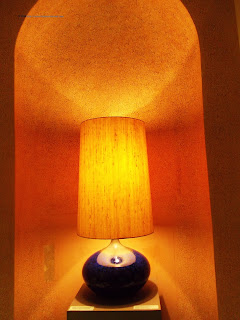Almost three years ago, it was a beautiful spring day and I left home having in mind to visit the Ceramic Museum. But I don't remember what happened and my plans were switched for some outdoor activities probably. This time, with the snow being around the corner, it was cold enough to be very strict about my schedule. The small museum is situated in Charlottenburg, a couple of minutes away from Richard-Wagner Platz U-Bahn station.
The visitors are invited to see three different exhibitions: one permanent collection of German porcelain from the 19th century, and two other temporary exhibitions changed almost every 6 months. The main collection includes beautiful samples of local art, with or without flower and natural prints in general, produced by German manufacture. Many of them were and still are popular items in the living rooms of the middle class local society.
The exhibition halls are distributed through the building. The museum is hosted in the oldest construction in Charlottenburg, originally built in the 18th century. What is nowadays the main garden with stylish arcades used to be a huge dancing hall that was destroyed over night by the 1980s owners. A very bad and unauthorized decision, as the building was and still is part of the local heritage. After this experience, it was transferred under the authority of the townhall who subsidize it.
One of the main temporary exhibitions features the coffee and dining culture from 'Urbino' to 'Stambul'. It presents various items produced by the KPM Porcelain Manufactur in the 1930s and later on, one generation later. It features various works by Marguerite Friedlaender and Gerhard Marcks, brand names of the local design scene for years. It is not easy to find the charm of the strict monotone geometry and the strict lack of colour diversity, but there is some mystery of the geometry that cannot be neglected. The exhibition hall has also a small corner where the coffee drinkers can rest and sip their take away coffees in an inspiring ambiance.
The last exhibition is dedicated to the German artist Walter Rhaue, that brings back the colours into my day. Besides the religious subjects, he also decorated plates and small statues in lively nuances and in a humorous way.
I wished my visit in this warm space with so many colours and shapes lasts longer. Before leaving, I had a look at the selection of books from the local library - good looking hard covered books with many useful information about the German porcelain traditions - and was introduced a bit more into the history of the building by the director of the museum. This may be the advantage of visiting a small homely place: you will always find nice people ready to tell you local stories.






Keine Kommentare:
Kommentar veröffentlichen